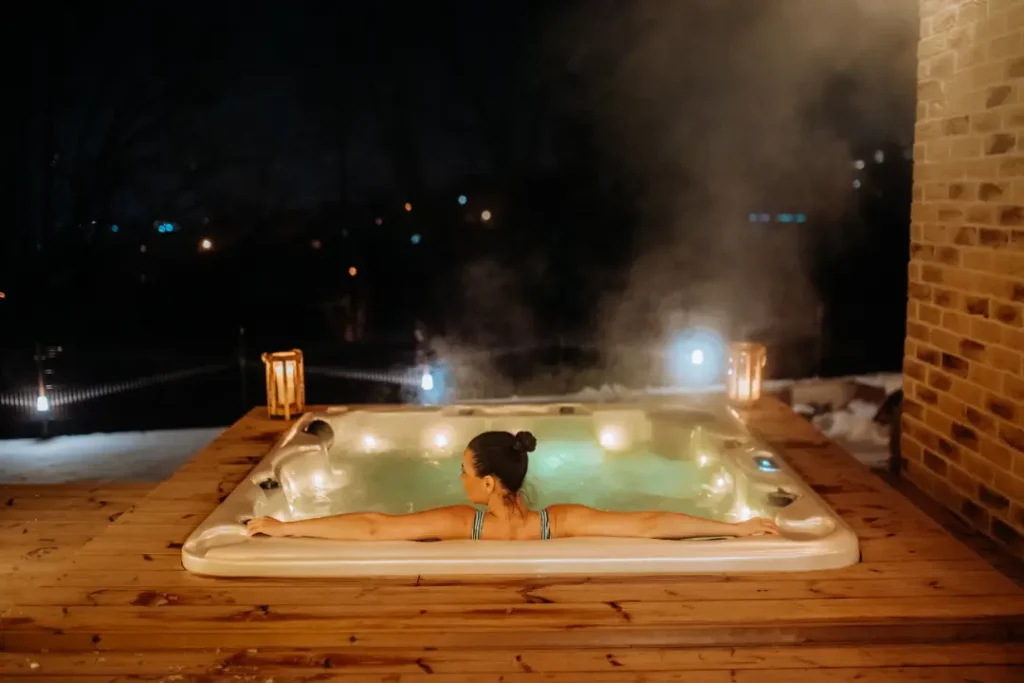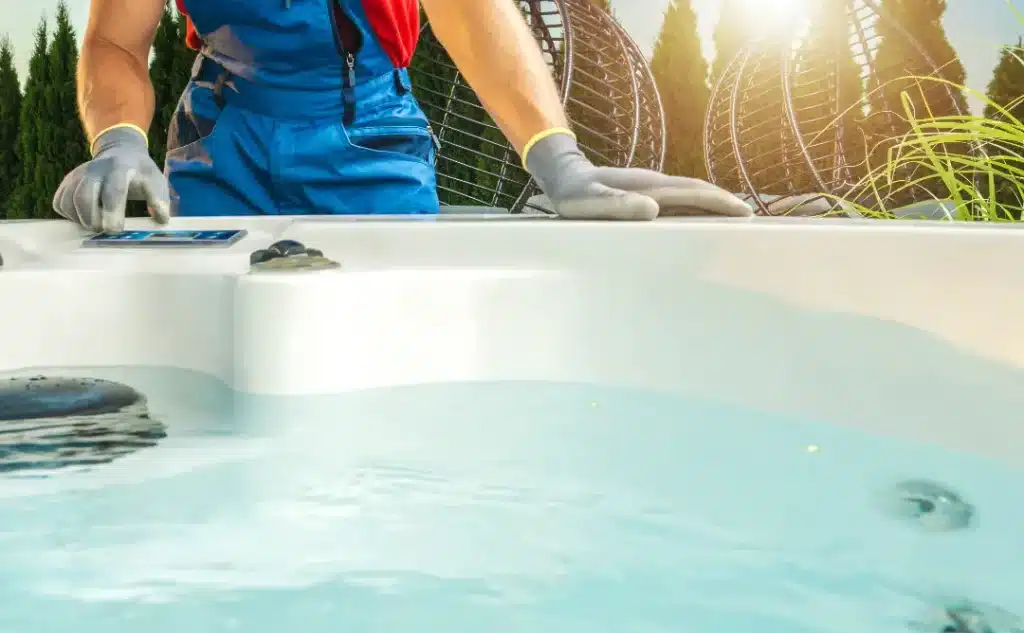How long does it take to heat a hot tub? On average, it usually takes between 4 to 6 hours. However, this time can vary based on factors such as heater power, the starting water temperature, and insulation quality.
In this article, we will cover these factors in detail and provide tips to speed up the heating process.
Key Takeaways
- Heating time for hot tubs varies based on heater power, starting water temperature, and insulation quality, with average times ranging from 3 to 8 hours.
- To speed up heating, keep the cover on, use windbreaks, and turn on the jets for better heat distribution.
- Regular maintenance, proper insulation, and consistent usage are key to enhancing your hot tub’s heating efficiency.
What Are the Factors Influencing Hot Tub Heating Time?
The duration required for a hot tub to reach the desired temperature is influenced by numerous elements that contribute significantly to the heating process. Recognizing these factors enables owners of hot tubs to adjust their expectations and enhance the efficiency of heating. Critical aspects include the strength of the heater, the initial water temperature, and how well insulated it is.
These components are essential in determining both the speediness and effectiveness with which your hot tub can become adequately heated.

Heater Power
The strength of the heater greatly influences how quickly a hot tub reaches the desired temperature. To ensure efficient heating, it’s crucial to select a heater with an adequate power output that corresponds to the dimensions of the hot tub.
Heaters with higher kilowatt ratings not only heat up faster but also maintain temperatures more effectively.
Incorporating top-notch parts such as tankless water heaters, pumps, and jets can expedite the warming process while simultaneously lowering energy expenditures.
Water’s Starting Temperature
The starting temperature of the water greatly influences the time it takes to heat your hot tub. If you begin with water at 50°F, reaching the desired temperature will require more time than if you fill your tub with water that is already warmer.
It’s crucial to take into account both ambient and initial water temperatures as they play a key role in efficiently heating up the hot tub during the heating process.
Since ambient temperature and outside temperature can vary greatly, starting with colder water means your hot tub takes significantly longer to warm up. Many factors, like seasonality and weather patterns, can impact the final heating time.
Insulation Quality
Insulation plays a vital role in determining the duration required for a hot tub to become hot. Superior insulation facilitates the retention of heat, which diminishes the amount of time needed for heating by curbing heat loss.
By incorporating effective insulating materials like high-density foam, you ensure that the warmth is maintained inside the tub, thereby optimizing both efficiency and cost savings during the heating process.
Allocating funds towards quality insulation can markedly improve your hot tub’s ability to efficiently generate and maintain heat.
Typical Heating Times for Most Hot Tubs
The duration required for a hot tub to warm up fluctuates according to its dimensions and various other determinants. Generally, most hot tubs need about 4 to 6 hours before they hit the preferred temperature level. Nevertheless, depending on particular circumstances, this timeframe can extend from as little as 3 hours to as much as 8 hours. The time it takes for a hot tub’s heating process can vary greatly.
To provide clearer insight into how long you might expect your own tub’s heating phase to take, let us explore typical heat-up times associated with different sizes of hot tubs in terms of the number of hours necessary.
Small Hot Tubs
Hot tubs with a smaller size typically heat up more quickly than their larger counterparts because they contain less water, allowing them to attain the desired temperature in a shorter time frame, usually between 3 and 5 hours.
This efficiency not only provides quicker access to a hot tub but also reduces energy usage, making these models well-suited for individuals who prioritize faster heating times and energy conservation.
Medium-Sized Hot Tubs
Medium-sized hot tubs typically take around 4 to 6 hours to heat from cold to the desired temperature under standard conditions.
The heating time can be influenced by several factors, including the efficiency of the heater, the starting water temperature, and the quality of the insulation.
Large Hot Tubs and Swim Spas
The process of heating larger hot tubs and swim spas, which have a greater volume of water, can be quite extended. It frequently takes them between 6 to 8 hours or possibly more to attain the temperature that users desire. Because larger tubs heat fewer degrees per hour compared to small units, it makes more sense for a hot tub owner to invest in a stronger heat source.
A high-performance heating element can make a huge difference when trying to reach a comfortable temperature faster. This extended duration is critical for guaranteeing uniform heat distribution across the expansive water area within the tub.
Robust heaters and superior insulation are vital components for effectively controlling the time it takes to heat these sizable units.
How to Speed Up Your Hot Tub Heating Process
There are a number of beneficial strategies to expedite your hot tub’s heating process and enhance energy efficiency. These techniques are designed to quicken your tub’s warming and conserve energy.

Keep the Cover On
Employing a top-notch hot tub cover is crucial in maintaining heat retention and expediting the process of heating up the tub.
A cover that provides good insulation greatly diminishes heat loss, thus prolonging the duration for which the water stays warm.
Ensuring that this insulated cover remains on during heating serves to confine the warmth within, resulting in a more rapid increase in temperature and consequently reducing energy expenditure.
Covers designed with tapered edges help retain heat more effectively, minimizing the impact of outside temperature on your hot tub’s water. This simple step can greatly lower energy costs while keeping your hot tub running efficiently all year round.
Use Windbreaks
By constructing barriers like fences or carefully positioned shrubs around your hot tub space, you can significantly reduce the loss of heat caused by wind.
These windbreaks serve to shield the hot tub from windy conditions that lead to cooling, thereby greatly improving heating effectiveness.
Such straightforward installations enable owners of hot tubs to experience a more effective process for heating their tub, particularly during the colder winter period.
Turn on Jets
Activating the jets during the hot tub’s heating phase facilitates more uniform dispersal of heat throughout the water, helping to eliminate cold pockets.
This movement of hot water accelerates the efficiency of the heating process, allowing for a quicker attainment of your preferred temperature.
When you engage these jets, it expedites how quickly the hot tub warms up, enriching your experience with consistent and ample warmth.
Utilizing these powerful jets can markedly improve how effectively and rapidly your hot tub reaches those hotter temperatures that are so desired.
How to Maintain Optimal Hot Tub Efficiency
To keep your hot tub heating quickly and operating efficiently, it’s essential to maintain ideal conditions. This involves regular maintenance, proper insulation, and consistent usage.
By focusing on these key areas, you can ensure a more enjoyable experience every time you use your hot tub, offering both efficiency and relaxation.
Regular Maintenance
It is essential to conduct routine maintenance to preserve the heating efficiency and general functioning of your hot tub. This includes periodic inspections and cleaning of filters, which must be kept free from blockages for peak performance. Optimal water flow, necessary for efficient heating, relies on a clean filter.
Servicing the heater in your hot tub regularly is critical as it helps prevent complications such as scale accumulation that can impair the effectiveness of heating.
Proper Insulation
The quality of materials utilized in constructing the hot tub greatly influences its capacity to insulate properly. Without quality insulation, a poorly insulated hot tub can lose warmth quickly, forcing the hot water tank and heater to work harder. Maintaining the hot tub temperature close to your personal preference will require much less effort if you can efficiently conserve heat inside the tub.
Ensuring effective insulation is crucial for sustaining a consistent water temperature and diminishing the need for prolonged heating. By equipping your hot tub with superior insulation, you can prevent substantial heat loss, thereby simplifying the process of keeping the water at your preferred temperature.
Employing an insulated cover is imperative for preserving heat within the tub and curtailing energy expenditures.
Consistent Usage
Maintaining a stable temperature in your hot tub can lead to greater energy efficiency. This continuous regulation of heat mitigates the demand for high-energy consumption that comes with frequent reheating, conserving energy, and ensuring user comfort.
By consistently keeping the hot tub at the desired temperature, it remains prepared for use constantly, eliminating the lengthy periods often required to bring a cold tub up to a hot state.
Common Issues Affecting Heating Time
Identifying and resolving certain prevalent problems is essential for maintaining your hot tub’s efficiency, as these can significantly impact the time it takes to heat up. These critical issues generally include malfunctioning heaters, inadequate insulation, and clogged filters.

Faulty Heater
A defective heater often impedes the process of heating a hot tub, which is an issue that frequently occurs. It’s important to detect a malfunctioning heater promptly in order to preserve the effective functioning of your hot tub.
Expert diagnostic services are best for quickly identifying and remedying heating issues, guaranteeing that your hot tub functions with maximum efficiency.
Poor Insulation
Inadequate insulation in a hot tub can lead to significant efficiency issues and affect its performance by allowing heat to escape. This results in prolonged heating times and elevated energy expenses due to increased heat loss.
Ensuring proper insulation can prevent these problems, thereby improving the efficiency of the heating process.
Blocked Filters
If the filters of your hot tub become clogged, it can greatly hinder its ability to heat properly. When these filters are dirty, there’s a decrease in water flow that can severely affect the heating capability of the tub.
Ensuring that you clean the filters on a regular basis will help maintain efficient water movement and keep the heating function of your hot tub at peak performance.
Why Choose Action Spa Repair for Your Hot Tub Needs?
At Action Spa Repair, we specialize in fast, reliable hot tub repair throughout San Diego County. Since 1993, we’ve been the trusted name for homeowners needing expert service and speedy results.
Whether your hot tub won’t heat properly, jets aren’t working, or you’re seeing error codes, our skilled technicians diagnose and repair issues quickly, often faster than competitors, thanks to our in-house parts warehouse and cutting-edge remote technician support.
We service all major brands and models and offer a wide range of repairs, from leak detection to system upgrades, heater repairs, jet replacements, pump servicing, and even custom hot tub covers. With over 20 years of experience, our team ensures every customer gets fast, professional results with a service warranty for total peace of mind.
What We Offer
- Fast, efficient repairs for all brands and models
- On-hand parts inventory for quicker service
- Highly trained technicians with remote field support
- Leak repairs, heater fixes, pump services, custom covers, and more
- Warranty-backed repairs for your peace of mind
Call Action Spa Repair today at 619-444-1720.
Frequently Asked Questions
How long does it typically take to heat a hot tub?
It typically takes about 4 to 6 hours to heat a hot tub to your preferred temperature, but that can vary based on different factors like the heater’s power and the initial water temperature.
So plan ahead for the perfect soak!
What is the most significant factor affecting hot tub heating time?
The power of the heater is the most significant factor affecting hot tub heating time. A more powerful heater warms the water faster, to suit your needs.
Why is regular maintenance important for my hot tub?
Regular maintenance is crucial for your hot tub because it keeps the heating system efficient, helps avoid costly repairs, and significantly extends its lifespan.
Staying on top of maintenance means more relaxing days in your tub!
What services does Action Spa Repair offer for hot tubs?
Action Spa Repair provides diagnostic services and comprehensive repairs to ensure your hot tub stays in top shape.
Conclusion
It is essential to grasp the various elements that impact the time it takes for a hot tub to heat up. This includes the heater’s strength, the water’s initial temperature, and how well-insulated your spa is. Enhancing these factors can accelerate heating speeds and maintain high efficiency levels so you can make more frequent and easier use of your hot tub.
Consistent upkeep, along with promptly dealing with typical issues, will keep your tub in top shape. Relying on professional services such as those we offer at Action Spa Repair ensures smooth operation and adds reassurance for users who want their hot tub functioning seamlessly.
